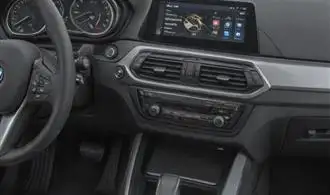
Activate Advanced Safety Features
The BMW X3 is equipped with a range of advanced safety features that can enhance the overall driving experience and provide an extra layer of protection. One of the key features is the Active Driving Assistant, which includes a suite of technologies designed to monitor the vehicle's surroundings and intervene when necessary. To activate these advanced safety features, follow these steps:
1. Familiarize yourself with the control system: The BMW X3's iDrive system allows you to access and customize the various safety features. Spend some time exploring the menu options and understanding how to enable and configure each feature to your preferences.
2. Enable Collision Warning: This feature uses radar sensors to detect the potential for a collision with a vehicle or pedestrian ahead. When a collision risk is detected, the system will provide visual and audible alerts, allowing you to take immediate action to avoid or mitigate the impact.
3. Activate Lane Departure Warning: This system uses a camera to monitor the vehicle's position within the lane. If the X3 begins to drift outside of the lane without the turn signal activated, the system will provide a warning, prompting you to steer back into the correct lane.
4. Utilize Blind Spot Detection: The BMW X3 is equipped with sensors that can detect vehicles in your blind spots. When a vehicle is detected, the system will illuminate an indicator light in the side mirror, alerting you to the presence of the other vehicle before attempting to change lanes.
5. Engage Automatic High Beams: This feature uses a camera to detect oncoming traffic and automatically switch between high and low beams, ensuring optimal visibility without blinding other drivers.
6. Activate the Surround View Camera System: This feature provides a 360-degree view of the vehicle's surroundings, making it easier to maneuver in tight spaces or when parking. The system can be particularly useful when navigating narrow roads or reversing into a tight spot.
7. Enable the Parking Assistant: The Parking Assistant feature can help you find and guide you into available parking spaces. Simply activate the system, and it will steer the vehicle into the selected spot, while you control the throttle and brakes.
Optimize Brake Performance
Ensuring optimal brake performance is crucial for the safety and handling of your BMW X3. One of the most effective ways to optimize brake performance is by regularly maintaining and inspecting your brakes. This includes checking the brake pads for wear, ensuring the brake discs are in good condition, and addressing any issues promptly. Regularly flushing the brake fluid can also help improve brake responsiveness and prevent the buildup of contaminants that can compromise braking efficiency.
Another important factor in optimizing brake performance is monitoring your driving habits. Aggressive driving, such as sudden stops or frequent heavy braking, can take a toll on your brakes and reduce their effectiveness over time. By adopting a smoother, more controlled driving style, you can help extend the life of your brakes and maintain consistent performance.
Upgrading your brake components can also be a valuable investment for BMW X3 owners who want to enhance their vehicle's braking capabilities. High-performance brake pads, rotors, and calipers can provide improved stopping power, better heat dissipation, and more precise control. However, it's important to consult with a qualified mechanic or do thorough research to ensure any upgrades are compatible with your specific X3 model.
Improve Traction Control
The BMW X3's traction control system is a vital safety feature that helps maintain stability and grip on various road surfaces. By understanding how to optimize this system, you can enhance your driving experience and ensure your X3 remains firmly planted on the road. Here are some tips to improve your BMW X3's traction control:
Understand the System's Function: The traction control system in the X3 monitors the wheels for any signs of slippage. When it detects a wheel losing traction, it will automatically apply brake pressure to that wheel and adjust engine power to restore grip. This helps prevent the vehicle from spinning out or losing control, especially in slippery conditions.
Adapt to Driving Conditions: The effectiveness of the traction control system can vary depending on the driving conditions. In dry, clear weather, the system may not need to intervene as frequently. However, in wet, snowy, or icy conditions, the traction control will play a more critical role in maintaining control. Be mindful of the weather and road surfaces, and adjust your driving accordingly.
Consider the Tire Condition: The tires on your BMW X3 are a crucial factor in the effectiveness of the traction control system. Ensure that your tires are in good condition, with adequate tread depth and proper inflation. Worn or under-inflated tires can reduce the system's ability to detect and respond to traction loss.
Disable Traction Control for Specific Maneuvers: While the traction control system is generally beneficial, there may be instances where you want to temporarily disable it. For example, when attempting to extract your X3 from deep snow or sand, disabling the traction control can allow the wheels to spin more freely and help you gain momentum to get unstuck.
Understand the Limitations: It's important to recognize that the traction control system, while highly effective, has its limitations. It cannot overcome the laws of physics or compensate for reckless driving. Ultimately, the driver's skill and judgment remain the primary factors in maintaining control of the vehicle.
Enhance Driver Assistance Systems
The BMW X3 comes equipped with a suite of advanced driver assistance features that can significantly enhance the safety and convenience of your driving experience. One of the key systems to explore is the Driving Assistance Professional Package, which offers a comprehensive set of tools to help you navigate the road with greater confidence.
The Active Cruise Control with Stop & Go function is a standout feature, allowing you to maintain a safe following distance from the vehicle in front of you while automatically adjusting your speed to match traffic conditions. This can be especially helpful in congested city driving or on long highway trips, reducing driver fatigue and the risk of rear-end collisions.
Another invaluable feature is the Lane Keeping Assistant, which uses cameras to detect lane markings and gently steer the vehicle back into the lane if it begins to drift. This can be particularly useful on winding roads or during periods of drowsiness, helping you stay centered and focused on the task at hand.
The Frontal Collision Warning with City Collision Mitigation takes safety a step further by using radar sensors to detect potential collisions with vehicles, pedestrians, or cyclists in front of the X3. If a collision is imminent, the system can automatically apply the brakes to help mitigate the impact or avoid the collision altogether.
For additional peace of mind, the Blind Spot Detection system uses sensors to monitor your blind spots and provides visual alerts if a vehicle is detected in your blind spot, reducing the risk of side-impact collisions during lane changes.
Maintain Proper Tire Pressure
Proper tire pressure is crucial for the BMW X3's safety and performance. Underinflated tires can lead to poor handling, increased fuel consumption, and even blowouts, while overinflated tires can cause uneven wear and reduce traction. To ensure your X3's tires are at the recommended pressure, routinely check them using a high-quality tire pressure gauge. The optimal tire pressure for your BMW X3 can be found in the driver's side door jamb sticker or in your owner's manual.
When checking your tire pressure, make sure the tires are cold, meaning you haven't driven the vehicle for at least three hours or have driven less than a mile at moderate speeds. This will give you an accurate reading, as the tires heat up during driving and the pressure increases. If the pressure is too low, inflate the tires to the recommended PSI. If the pressure is too high, release air until the tires reach the correct level.
It's also important to regularly rotate your tires to ensure even wear. Proper tire rotation can help maintain the correct tire pressure and extend the life of your tires. Consult your owner's manual for the recommended rotation pattern and interval. Additionally, consider investing in a tire pressure monitoring system (TPMS) to alert you when one or more tires are underinflated, allowing you to address the issue promptly.
















